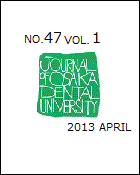All issues

Volume 27 (1993)
- Issue 2 Pages 67-
- Issue 1 Pages 1-
Volume 27, Issue 1
Displaying 1-4 of 4 articles from this issue
- |<
- <
- 1
- >
- >|
-
Shingo SAIJO, Tadataka SUGIMURAArticle type: Article
1993 Volume 27 Issue 1 Pages 1-22
Published: 1993
Released on J-STAGE: October 31, 2016
JOURNAL FREE ACCESSWe investigated the magnitude of various maxillary occlusal forces and the direction in which such forces were propagated. Adult monkeys were anesthetized and forced to occlude on sticks of 3, 5 and 7 mm thickness at the canines, second premolars and second molars. Electrical stimulation was applied to the masseter and temporalis muscles, and measurements of magnitude, direction and character of principal strains were recorded. Readings for the surface of the maxilla indicated that bone sutures and adjacent cavities are intimately and functionally related to the buffering of these occlusal forces.
The maxilla deformed as the premaxilla was pushed out in the region of the premaxillomaxillary suture. The nasal bone was stretched anteroposteriority in the region of the nasomaxillary suture as the space that arose due to contraction of the masseter muscle was filled in the region of the zygomaticomaxillary suture. In addition, when occlusal forces were imparted on the maxilla, the surfaces of this bone bulged out due to the effect on adjacent bone cavities.
Results demonstrated that the maxilla dispersed occlusal force well by these mechanisms. Accordingly, there were very few regions in this bone where stresses concentrated.View full abstractDownload PDF (1215K) -
Yoshinori TANI, Kenji UCHIHASHIArticle type: Article
1993 Volume 27 Issue 1 Pages 23-35
Published: 1993
Released on J-STAGE: October 31, 2016
JOURNAL FREE ACCESSWe sought to determine the effect of substance P salivary stimulation on both electrical charges and cellular permeability in the tight junctions of rat submandibular gland cells. Microperoxidase (1,900 daltons) was used as a tracer. It was administered by close-arterial infusion via the glandular arteries, and secretory routes of acinar cells in the gland were determined cytochemically. In the resting gland, microperoxidase reaction product filled the lateral intercellular spaces up to the tight junctions, but did not penetrate them. In the substance P-stimulated gland, microperoxidase reaction product was present within tight junctions and the lumen.
Both distribution and mobility of anionic sites on the surface of the submandibular gland cells were studied utilizing multivalent ligand, ruthenium red and cationized ferritin as probes. In the resting gland, ruthenium red deposits were located uniformly in all areas of the basal membrane and intercellular spaces except for the tight junctional region of acinar and ductal cells. In substance P-stimulated gland, ruthenium red deposits were present in the tight junctional region and, to a lesser extent, in the intercellular spaces. Electrical charges of the tight junctions area of the lateral plasma membrane were studied using intraductal injection of cationized ferritin. In the resting gland, cationized ferritin probe was present in the intercellular spaces and was bound weakly in the tight junctional region. In the substance P-stimulated gland, cationized ferritin was firmly adherent to the tight junctional region.View full abstractDownload PDF (2316K) -
Toshiya MORITA, Aiko KAMADAArticle type: Article
1993 Volume 27 Issue 1 Pages 37-49
Published: 1993
Released on J-STAGE: October 31, 2016
JOURNAL FREE ACCESSAge-related changes in cerebral hyaluronic acid (HA) and chondroitin sulfate (CS) in senescence-accelerated mice (SAM-P/8//Odu, P substrain) were investigated. SAM-R/1//Odu (R substrain) mice were used as controls. Levels of both HA and CS extracted from the defatted dry cerebrums at 7, 17, 27 and 37 weeks of age were determined by HPLC analysis after conversion to unsaturated disaccharides following enzymatic digestion.
Glycosaminoglycan content (determined as uronic acid) was lower in P substrain mice than in the age-matched controls at all ages tested. Though the ratio of HA to CS was increased at 17 and 27 weeks in control mice, this ratio for the P substrain was already high at the initial test at 7 weeks and remained so thereafter. The CS chain consisted mainly of ΔDi-4S, with ΔDi-0S and ΔDi-6S present only as minor components at all ages in both substrains. The HA chain consisted only of ΔDi-HA for all ages in both substrains. The relative amount of each unsaturated disaccharide was higher in the R substrain than in the P substrain mice at all ages.
We found that qualitative and quantitative changes in cerebral CS and HA were expressed relatively early in the P substrain mice compared to controls. We propose that these changes are associated with and may cause physiological and functional alterations associated with senescence in the CNS.View full abstractDownload PDF (956K) -
Minoru HATAArticle type: Article
1993 Volume 27 Issue 1 Pages 51-66
Published: 1993
Released on J-STAGE: October 31, 2016
JOURNAL FREE ACCESSI determined the effect tongue forces imparted on a palatal bar has on the growth and development of the dentofacial complex of the Macaca irus. Ten female Macaca irus monkeys with mixed dentition were used in this experiment. The animals were divided into four groups, two animals were treated for 30 days, two for 90 days, and four for 180 days, with the remaining two animals serving as controls.
The following results were obtained.
1. There was disocclusion on the maxillary and mandibular first molars.
2. Elongation of the mandibular first molars resulted from intrusion of the maxillary first molars.
3. The maxillary complex displayed a positional change with slight clockwise rotation.
4. Growth of the frontozygomatic site in the anteroinferior direction was inhibited.
5. There was no anterosuperior mandibular growth.
6. Changes in the maxillary suture and positioning of the teeth were mainly due to the effects of the tongue function imparted on the palatal bar.
With enough control of the vertical growth of the maxilla can be validated. This is one of many methods of treating Class II malocclusion.View full abstractDownload PDF (2115K)
- |<
- <
- 1
- >
- >|